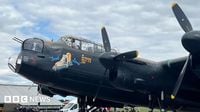The skies above the British Isles are set to echo with the legendary roar of World War Two aircraft, as both the iconic Spitfire and the rare Lancaster bomber take center stage in two remarkable aviation stories unfolding in 2025. For aviation enthusiasts, military historians, and anyone with a soft spot for the romance of flight, these developments offer a powerful reminder of the enduring allure—and emotional resonance—of these historic machines.
Starting June 9, 2025, the Isle of Man will play host to a series of Spitfire flights that promise to be nothing short of spectacular. According to the BBC, these passenger flights, operated by Fly a Spitfire, mark the first time the firm has brought its commercial Spitfire experience to the island after a decade of flying from Biggin Hill. For three weeks, seven flights a day will take off and land from Ronaldsway airport, each a 35-minute journey cruising at about 200 mph (321 km/h) and circling the island’s dramatic coastline.
"We don't see any reason why we shouldn't be able to go all the way around the entire island, which should be spectacular, and it's also nice that people on the ground can see us as well," said Darren Dray, commercial manager for Fly a Spitfire, in comments to the BBC. The company will be based at the Isle of Man's Military and Aviation Museum, giving passengers direct access to the airfield and offering a daily spectacle for locals and visitors alike.
The Spitfires themselves are steeped in history. All three aircraft operated by the firm were originally built in the mid-1940s. Two have been converted from single-seaters to two-seaters, while the third was always a two-seater prototype. The Spitfire’s role in turning the tide of World War Two is legendary—credited with besting the German Luftwaffe’s Messerschmitts in the pivotal 1941 Battle of Britain and, as many believe, helping to secure the Allies’ eventual victory.
But this isn’t just a history lesson—it’s a living, breathing experience. The flights, which cost £4,950 per passenger, are marketed as a "once-in-a-lifetime experience," and for many, the emotional impact is profound. "It's something special to stand next to the aircraft when it's just landed, and it's ticking, it's warm, you can smell it, and it's got some bugs on it. It's not a pristine museum exhibit, it's a living thing and it's lovely to be still operating these aircraft all this time later," Dray explained.
The timing is no accident: the flights are scheduled to follow immediately after the Isle of Man TT event, hoping to attract both visitors and locals who are already in the mood for speed and spectacle. "Obviously we're fans of all things with engines and speed, so that's certainly on our radar," Dray added. The experience is particularly poignant for older customers, some of whom have vivid memories of Spitfires flying overhead during the war. "It is a very emotional thing and quite often people do take a little moment afterwards and collect their thoughts. But there's definitely a smile that lasts for a long, long time afterwards," said Dray. In fact, among the passengers is a 103-year-old, underscoring just how deep the connection runs between these aircraft and the generations who lived through the conflict.
While the Spitfires are once again gracing the skies, another aviation icon is being painstakingly prepared for its own return to flight: Lancaster NX6-11, better known as Just Jane. At the Lincolnshire Aviation Heritage Centre in East Kirkby, England, a dedicated team is halfway through a 10-year project to restore this rare bomber to airworthiness. Of the 7,377 Lancasters built during and after World War Two, only two are currently flying—making Just Jane’s restoration a mission of both technical ambition and national significance.
"It's extremely emotional for me and everyone who's worked on it," said Andrew Panton, owner of both the aircraft and the heritage centre, in an interview with the BBC. For the Panton family, the project is deeply personal. The loss of Andrew’s great uncle Christopher during Bomber Command operations over Nuremberg in 1944 inspired his grandfather Fred and great uncle Harold to create a living memorial to Bomber Command. When the opportunity arose in 1983 to purchase both the Lancaster and the old airfield at East Kirkby, they seized it, merging their passion for aviation with a family tribute to sacrifice and remembrance.
The restoration itself is a feat of ingenuity. "There is nothing on the Lancaster that you can just order off the shelf," Panton explained. Every part must be custom-built or modified, and sourcing engines and components has been a years-long challenge. A team of about 30 people—including 20 volunteers and 8 engineers—are currently restoring key sections such as the port wing, nose, rear fuselage, and tailplane. Parts have even been sourced from the RAF's Battle of Britain Memorial Flight’s own Lancaster, which regularly performs at air displays.
Volunteers bring their own stories and motivations to the project. Rob Harvey, a former RAF engineer, first encountered Just Jane in 1970 and now makes a weekly journey from Bourne to work on the restoration. "My wife defines this [Just Jane] as one of my happy places," Harvey said. "It's something I thought I would never get a chance to do at my age." Jodie Elcock, who joined after a 28-year career at RAF Coningsby, echoed the sentiment: "Since I was seven years old I've been wanting to work on aeroplanes. I've done 28 years of air force stuff and now I carry on the aspiration of working on old aeroplanes. I'm happy as long as I can work on Just Jane."
Just Jane’s history is as storied as the people restoring her. Built in 1945, she served with the French navy before spending years as a gate guard outside RAF Scampton. The aircraft has also appeared in films and TV shows, including Doctor Who, and even caught the attention of television presenter and former motorcycle racer Guy Martin, who is now supporting the restoration. "I'm putting a bit back in and anything they need from me to help oil the wheels to get it up in the air. We're five years into the 10-year project, but it is happening, the ball is rolling," Martin said.
When the restoration is complete, Just Jane will become one of only three airworthy Lancasters in the world, joining the ranks of the Battle of Britain Memorial Flight and the Canadian Warplane Heritage Museum. For Panton and his team, the moment Just Jane takes to the skies will be the culmination of decades of work and a tribute to those who served and sacrificed. "That day when the Lancaster takes to the air for the first time, obviously it's extremely emotional for me and everyone who's worked on it. But also seeing the joy it brings to people who've come to see it fly. It'll be incredible. I'm sure the first thing I'll be thinking is I hope it comes back," Panton reflected.
As these historic aircraft return to the skies and the public eye, they serve not only as living memorials to a turbulent past but also as reminders of the enduring power of engineering, community, and collective memory.




